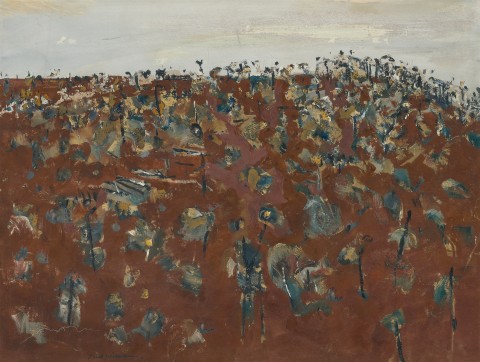UPWEY LANDSCAPE, c.1965
FRED WILLIAMS
gouache on paper on composition board
55.5 x 73.0 cm
signed lower left: Fred Williams.
artist's label attached verso with number, artist’s name, title, medium and dimensions
Probably: Rudy Komon Gallery, Sydney
The National Australia Bank Art Collection, acquired in 1970 (label attached verso)
Upwey Landscape, 1965, oil on canvas, 147.5 x 183.3 cm, in the collection of the National Gallery of Victoria, Melbourne
One of the most important Australian artists of the twentieth century, Fred Williams transformed the tradition of landscape painting in this country. His unique vision of the natural environment – from areas of scrubby bush on the edges of suburbia, to the vast inland country – captured its essence and created archetypal images that have become part of our collective visual memory. Produced during the mid-1960s at a time when Williams, confident and mature, emerged as a key figure in contemporary Australian art, the Upwey Series sits alongside the preceding You Yangs works as ‘classic’ Williams. Articulating their significance both within Williams’ oeuvre and the broader context of Australian landscape painting, Patrick McCaughey wrote, ‘They were clearly paintings of substance, well made and fully fashioned and yet they still allowed [his] touch to operate. They made of the drab and featureless bush, a landscape of enduring, even monumental proportions and dignity. They revalued Australian landscape painting… and renewed hope in the genre.’1
While Williams had previously painted in and around Upwey, in the Dandenong Ranges to the east of Melbourne, it was the experience of living there from 1963 which provided the impetus for a major series. Now able to paint full-time, he established a studio in the house by joining two rooms together, and the view looking from the valley up the hill to the sky above informed the composition of these images, which are characterised by a narrow band of sky running across the top of a steep, treed slope.2 The strength of the series was recognised early, with the National Gallery of Victoria acquiring Upwey Landscape III, 1965 from the studio the year it was painted. Major Upwey paintings are also held in the collections of the National Gallery of Australia, Art Gallery of New South Wales and Tate, London.
Williams worked in various media throughout his career – the technical possibilities and creative innovations of one, influencing his work in another – and Upwey subjects feature in drawings, etchings, gouaches, as well as oil paintings. A quick-drying medium composed of watercolour mixed with white pigment (which renders it opaque), gouache was his preferred medium for painting outdoors during the mid-sixties. As this example shows however, in addition to its convenience and ease of use, in Williams’ hands, gouache also offered something of the richness of oil paint in terms of the pictorial possibilities and textural manipulation it allowed. The familiar format of the Upwey landscapes is combined here with a luscious wintry palette, a hillside of deep browns, ochre and grey, beneath a pale sky streaked with painterly clouds. Williams’ trademark daubs and dots of paint describe dense vegetation growing across the top of the hill and tree trunks, strongly defined in black, mark out the topography of the hillside, the verticals of standing trees creating a staccato-like rhythm across the picture which is counterbalanced by the series of horizontal lines at centre left depicting a group of recently felled trees.
1. McCaughey, P., Fred Williams 1927 – 1982, Murdoch Books, Sydney, 1996, p. 170
2. See Mollison, J., A Singular Vision: The Art of Fred Williams, Australian National Gallery & Oxford University Press, Canberra, 1989, p. 89
3. In the late 1960s Williams began to make small outdoor oil sketches, adding acrylic paint to his repertoire of outdoor materials in 1971.
KIRSTY GRANT
